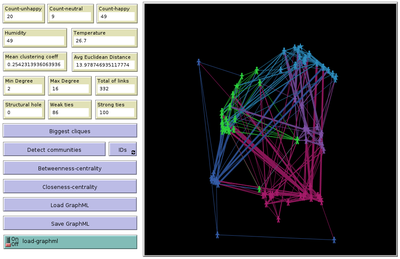Cellular automata model of social networks 1.0.0
This project was developed during the Santa Fe course Introduction to Agent-Based Modeling 2022. The origin is a Cellular Automata (CA) model to simulate human interactions that happen in the real world, from Rubens and Oliveira (2009). These authors used a market research with real people in two different times: one at time zero and the second at time zero plus 4 months (longitudinal market research). They developed an agent-based model whose initial condition was inherited from the results of the first market research response values and evolve it to simulate human interactions with Agent-Based Modeling that led to the values of the second market research, without explicitly imposing rules. Then, compared results of the model with the second market research. The model reached 73.80% accuracy.
In the same way, this project is an Exploratory ABM project that models individuals in a closed society whose behavior depends upon the result of interaction with two neighbors within a radius of interaction, one on the relative “right” and other one on the relative “left”. According to the states (colors) of neighbors, a given cellular automata rule is applied, according to the value set in Chooser. Five states were used here and are defined as levels of quality perception, where red (states 0 and 1) means unhappy, state 3 is neutral and green (states 3 and 4) means happy.
There is also a message passing algorithm in the social network, to analyze the flow and spread of information among nodes. Both the cellular automaton and the message passing algorithms were developed using the Python extension. The model also uses extensions csv and arduino.

Release Notes
There are two types of agents (breeds): clients (person shape) and service providers (star shape). Each one of them carries an internal state from 0 to 4, and also the amount of information, a float starting at 0 (no information at all) and greater than that (amount of information carried).
Each agent breed will choose two neighbors within the radius of interaction: an agent with the same breed as itself and an agent of another breed. This set will be used by the cellular automaton algorithm to generate the future state of the agent. Each agent will then move to the XY coordinate between the two neighbors. Note that in the case of lack of two neighbors, the agent can consider its two neighbors as a single other agent.
Information starts at level 1.00 for the individual with the biggest degree (connections in the social network), and 0.00 for all the others. It’s possible to note in the plot that the information flows through the network, increasing or decreasing its value over time.
Besides the interaction and the formation of social networks and information spread, the system is also subject to levels of temperature of the environment, measured with a sensor attached to Arduino.
